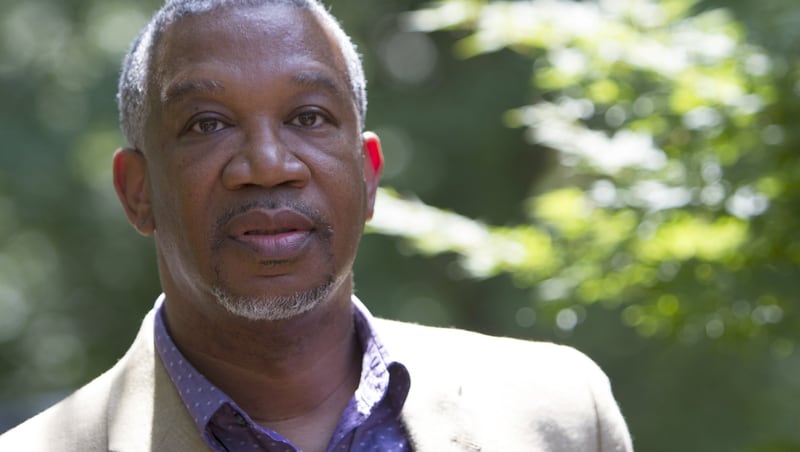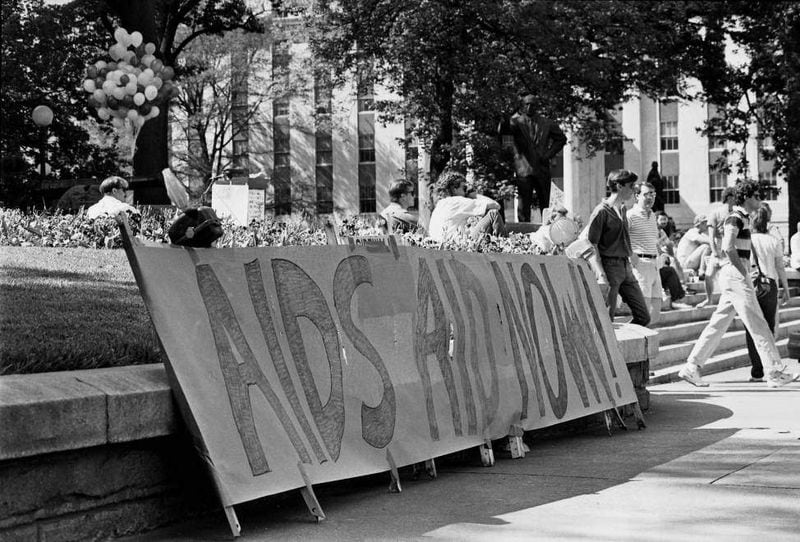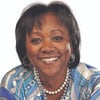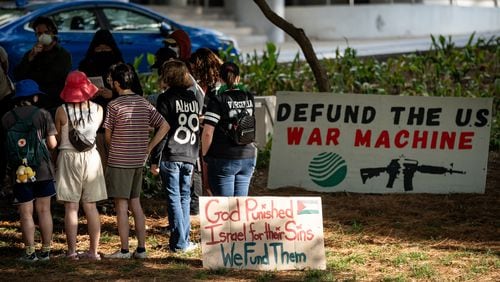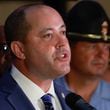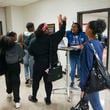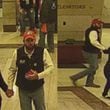This week, tens of thousands are expected to converge on Atlanta to celebrate Black Pride Week, one of the largest in the country. For many gay Black men, the celebration is mixed with a harsh reality. According to CDC, 1 in 2 gay Black men will be diagnosed with HIV at some point in their life. This week, in a five-part column series, you will hear from five gay Black men — including two who are HIV positive — who will share their personal stories and perspectives on why the epidemic has continued so long and why no one seemed to care. This is Part I.
The AIDS epidemic was already in full bloom the year Duncan Teague moved to Atlanta.
It was 1985. Four years earlier, the disease didn’t even have a name. Now it was considered the leading cause of death among single middle-aged men. The spread had become so fierce, in fact, scientists and public health authorities feared the disease could impact millions before a vaccine could be found.
Until then, Teague, then 24 and openly gay, had been watching the epidemic unfold on “The Phil Donahue Show.”
“In my head it was still coastal, and I suppose I thought there were some Black people who had it, but we had it on lock-down,” he said. “We really weren’t talking about it.”
Twenty-two years later, judging from the statistics, it’s still as though nobody is talking about it.
If current rates persist, one in two Black men who engage in homosexual activities will receive an HIV diagnosis in the United States during their lifetime. By contrast, one in 11 white men and one in four Latino men who engage in homosexual activity in the U.S. will be diagnosed with HIV, according to the Centers for Disease Control and Prevention.
I’ve been watching those numbers skyrocket since I was a cub reporter at the Sacramento Bee, but it wasn’t until a close friend’s son died of an AIDS-related illness that I had a personal connection to them.
So what happened to Black gay men? Didn’t they watch the news? Were they deliberately ignoring the warnings? Were the rest of us ignoring them? Were our schools providing evidence-based sex education programs that included LGBTQ couples? Were Black families talking about sexuality? Would it help if they did?
Of all the questions I had, only one held sway: Why, when rates for all other groups have decreased, are Black gay men disproportionately represented in an epidemic that was once considered a white gay male disease?
As reporters we’re taught to ask questions, but experience has taught me the answers depend on who you ask. I personally was done with so-called experts, of mining the statistics. I learned a long time ago numbers have names, that they breathe, take up causes and love.
And so over the next week, you will hear from five Black gay men -- including two who are HIV-positive -- who not only shared their personal stories but their perspective on why the epidemic has continued so long and why no one seems to care.
Duncan Teague, a resident of Decatur, is a Unitarian Universalist minister who has been involved in HIV activism for more than three decades.
When Teague arrived here in 1985, there were 15,403 AIDS cases in the U.S., including 263 in Georgia and 195 in metro Atlanta, double the number just a year earlier. Nearly 75 percent of people diagnosed were homosexual or bisexual men.
Even then Black gay men were disproportionately represented.
Teague became involved with AID Atlanta’s education program, joining an army of volunteers who visited hangouts to talk about the importance of wearing condoms.
Whether it was his own optimism or something else, Teague figured there’d be a cure in a few years, that he could help until then.
“I had a captive audience at Black and White Men Together meetings and some of the other gay places in town, and I was supported by AID Atlanta,” Teague recalled. “I thought, this is easy. We’ll all wear condoms.”
One of the ironies of that time, the Rev. Teague said, was that although there were no medical treatments for AIDS, there was a test for the virus, but people were discouraged from taking it.
“One of our first slogans was ‘No test is best,’ " Teague recalled. “If you think about what it was like to be gay in the ‘60s, ‘70s and ‘80s, and you’re going to go to the health department and have them say you have a communicable virus that will kill you, with no cure, it was scary.”
With that fear came other fears: Could they be quarantined? Would their employers be notified?
“There was a moment when (a) restaurant chain was known to have hired all these gay men and people were afraid to eat there. It was just fear,” Teague said. “Some people were contemplating how to deal with all these gay men with the virus.”
In 1986, Teague was tapped to represent Atlanta in the National Task Force on AIDS Prevention. That meant working with other gay men from across the country to try and stop the spread of HIV in his community.
At that time, Blacks made up about 25 percent of AIDS cases in the country, the Rev. Teague said.
“That was crazy because we only made up 12 percent of the country’s population, but we were treating it like we made up 2 percent of the cases. We were already over-represented in the earliest phases of the epidemic and not fighting back strong enough. Had we woken up then, the epidemic would be different.”
What held them back? The same things holding the reins now, Teague said, “Fear. Denial. Homophobia. And all the other stuff Black folk already had on their plates, including poverty, racism, misinformation and stigma.”
It didn’t help that the media virtually ignored Black gay men’s stories, and if you believed public health officials, the only high-risk groups were white gay men, hemophiliacs and Haitians.
“That was a mistake,” Teague said. “All the Black people who knew they weren’t Haitian said, OK, I’m all right.
“I have fantasies about what it would’ve been like if we had woke up and dealt with this when the numbers were small. So many thousands of people would have known how to protect themselves.”
For that to have happened, Teague said a complete cultural change about how gay men deal with sexuality, drug use and health would have been necessary. The Black community, in particular, would have “had to come to terms with the reality of sexual behavior and not just with what we say we’re saying, but what we were doing -- how to accept and recognize homosexuality.”
The notion that there were a few men who were a little crazy, that homosexuality was a mostly white male thing was decimating to the Black community.
As the epidemic raged, it outed people all sorts of ways. Teague lays the blame for much of this at the door of the Black church and believes a more pastoral loving response would’ve changed the spread of the epidemic.
“I know too many men who held somewhere in their minds the notion that they were dying and going to hell anyway, so what else mattered,” Teague said. “How was I going to prevent them from being infected when they had already concluded they were eternally damned for being who they are? Where is the energy about protecting your life, the people you love and the people you’re sexually involved with, in contrast to a heterosexual who can pray and ask forgiveness and then practice their sexuality blessed by everybody?”
In addition, Teague believes there were folks in power, people who funded public health efforts, who made decisions based on homophobia, racism, ignorance and a basic concern about their own political futures instead of good public health.
Credit: Billy Downs / AJC
Credit: Billy Downs / AJC
“When the majority of people with the epidemic turned out to be people of color, interest waned,” Teague said. “Even white gay writers talked about ‘the end of the epidemic’ because their numbers started dipping even though ours hadn’t.”
There’s no denying homophobia still exists, but we can’t ignore the progress that has taken place in just the past few years. Society is far more accepting of LGBTQ people than it was just 10 years ago. Today, a 63 percent majority say homosexuality should be accepted by society, and even Christians - 54 percent -- have become more accepting of homosexuality over time, according to a Pew Research Center study.
So how does he explain the disproportionate number of Black gay men who are HIV-positive?
“A lack of fear,” Teague said. Plus “young, pretty men at the height of their sexual prowess. Their hormones are going crazy, and, let’s face it, sex is wonderful. It feels good. Hallelujah. It’s simple to see how the numbers keep at a really high level.”
Ultimately, the Rev. Teague said Black gay men need to stop relying on interventions that target only them. The entire African-American community needs to address this stuff.
“No one is concerned about us anymore,” he said.
About the Author
